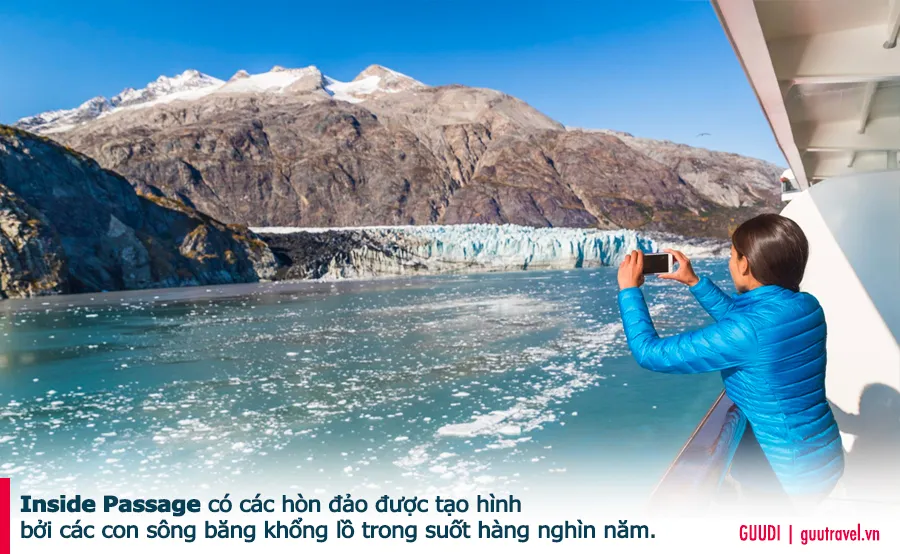Alaska, the final frontier of the United States, is famously known for its majestic mountain ranges, breathtaking glaciers, and pristine wilderness. Among the countless experiences Alaska has to offer, hiking on its snowy mountains stands out as an enchanting challenge, captivating the adventurous spirit of explorers and conquerors alike. This article from “Travel Around the World” shares valuable insights to help you prepare for and fully enjoy an unforgettable snowy mountain hiking adventure in Alaska, where raw beauty and nature’s extremes blend seamlessly.
Best Time for Hiking on Alaska’s Snowy Mountains
The most ideal time to experience snowy mountain hikes in Alaska is during winter and early spring, from November to April. During the winter, Alaska dons a blanket of pristine snow, creating a magnificent and serene natural landscape. The thick snow offers fantastic opportunities for snowshoeing, skiing, and exploring the icy beauty of the region.
Winter temperatures in Alaska can drop significantly, especially in higher altitudes. However, this freezing cold is precisely what makes the adventure of snowy mountain hiking so unique and captivating. You’ll witness frozen rivers, icy waterfalls, and snow-covered peaks glistening under the winter sun.
Spring (April and May) marks the transition between winter and summer, with melting snow, longer daylight hours, and gradually warming temperatures. However, in high-altitude areas, snow remains thick, providing excellent hiking conditions. Spring is also an incredible time to witness nature’s rebirth, with the first wildflowers blooming against the snowy backdrop.

Essential Preparation for Hiking on Alaska’s Snowy Mountains
Hiking on Alaska’s snowy mountains requires careful preparation—physically, mentally, and in terms of gear. Here’s what you need to keep in mind:
Build Your Physical Endurance
Before embarking on your journey, make sure you’re physically fit. Snowy mountain hiking demands both stamina and muscle strength. Engage in activities like hiking, mountain climbing, or cardio exercises to enhance cardiovascular health and overall endurance.
Pack the Right Gear
Proper gear is the key to ensuring safety and comfort during your hike. Here’s a checklist of essential items you should bring:
- Warm Clothing: Opt for layered clothing that provides insulation and is waterproof. Outer layers should block wind and snow, while inner layers retain body heat. Bring waterproof hiking pants, thermal gear, gloves, wool hats, buffs, and thermal socks.
- Specialized Hiking Boots: Boots should be waterproof with excellent traction for icy terrain and provide ankle support. Wear thick socks, and consider using thermal foot warmers if needed.
- Trekking Poles: These help maintain balance, reduce strain on knees, and support movement on slippery surfaces.
- Backpack: Select a backpack suitable for your trip’s duration, with sufficient space for water, food, spare clothing, a first aid kit, and other essentials.
- Sunglasses and Sunscreen: Sunlight reflecting off the snow can be extremely intense, potentially damaging your eyes and skin. Bring UV-protective sunglasses and sunscreen with a high SPF rating.
- Headlamp or Flashlight: These are essential for hiking at dawn, dusk, or nighttime.
- First Aid Kit: Carry essential supplies such as bandages, antiseptics, painkillers, altitude sickness medication (if needed), and personal medications.
- Map and Compass or GPS Device: These are crucial for navigation, particularly in bad weather or low visibility.
- Thermos and High-energy Snacks: Warm drinks and calorie-rich foods will help maintain energy and keep your body warm.
Research Terrain and Weather Conditions
Before starting your hike, study the terrain, elevation, and weather of your chosen region. Frequently check the weather forecast and be prepared for sudden changes.
Hike with an Experienced Partner or Join a Tour
If you’re new to snow hiking, consider partnering with an experienced hiker or joining guided tours. Professional guides provide expertise, knowledge, and support to ensure your safety and an enriching experience.

Spectacular Snowy Mountain Hiking Destinations in Alaska
Alaska is home to countless incredible hiking spots, ranging from popular national parks to lesser-known wilderness areas. Here are a few recommendations:
Denali National Park
Denali National Park is one of Alaska’s most iconic destinations, featuring Denali (formerly Mount McKinley), the highest peak in North America. In winter, Denali transforms into a wonderland draped in pristine snow.
You can explore Denali through various activities, including hiking on groomed trails, cross-country skiing, or guided snowshoeing tours. The Denali Visitor Center provides valuable information about hiking routes, weather conditions, and other park activities.
Kenai Fjords National Park
Kenai Fjords National Park is renowned for its stunning glaciers spilling into the sea and dramatic mountain landscapes. In winter, the park exudes an icy allure, with vibrant blue glaciers contrasting against pure white snow.
Snow hiking in Kenai Fjords offers a chance to marvel at unique landscapes, explore glaciers, and spot wildlife like mountain goats and seabirds. Exit Glacier is a popular and easily accessible area, featuring hiking trails suitable for all skill levels.
Kodiak National Wildlife Refuge
Kodiak National Wildlife Refuge encompasses vast, untouched wilderness and is home to the famous Kodiak bears, along with numerous other species of wildlife. In winter, Kodiak becomes even more tranquil, offering a secluded snowy hiking experience amidst pristine nature.
Explore Kodiak through hiking trails, cross-country skiing, or eco-tourism tours. It’s an excellent opportunity to spot Kodiak bears in their natural habitat, along with other wildlife like bald eagles and Sitka deer.

Safety Comes First
Hiking on Alaska’s snowy mountains is an incredible adventure but not without risks. Follow these essential safety tips:
- Always hike with at least one companion.
- Inform someone of your itinerary and expected return time.
- Carry a fully charged phone and a portable charger.
- Learn to navigate using a compass, GPS, or map.
- Stay alert to weather warnings and adjust plans if necessary.
- Stick to marked trails and avoid venturing off-path.
- Maintain hydration and energy by drinking water and eating regularly.
- Be aware of your surroundings and cautious of wildlife encounters.
- Understand symptoms of hypothermia and altitude sickness, and know how to respond.
- Never underestimate the power of nature.
Conclusion
Hiking on Alaska’s snowy mountains is a challenging yet highly rewarding journey. You’ll conquer snow-covered peaks, revel in the raw beauty of the wilderness, and experience the absolute stillness of Alaska’s untouched terrains. With thorough preparation and a spirit for adventure, you’ll create unforgettable memories on your snowy mountain hiking trip in Alaska. Contact “Travel Around the World” today to plan and embark on your Alaskan exploration!